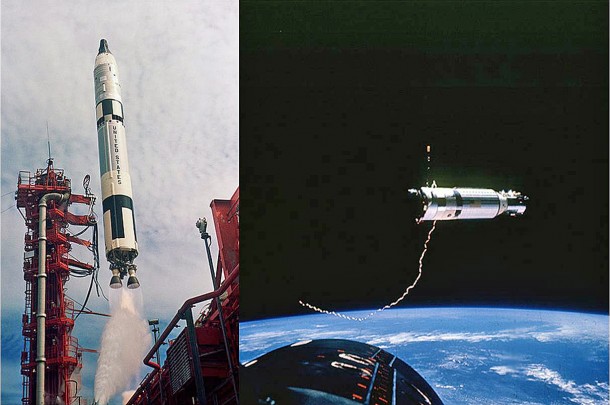
Forty-eight years ago today, Gemini 11 completed a spectacular 3-day mission that helped pave the way to the first manned lunar landing. The all-Navy crew included astronauts Charles P. Conrad, Jr. and Richard F. Gordon, Jr.
America’s manned space effort of the 1960′s and early 1970′s consisted of the Mercury, Gemini and Apollo Programs. Mercury put the first Americans into space and gave the country a basic manned spaceflight capability. Apollo put Americans on the Moon and returned them safely to the Earth. Gemini was the bridge. Without it, the United States could not have achieved the national goal of landing men on the Moon before the end of the 1960′s.
The Gemini Program consisted of ten (10) manned spaceflights that were flown between March of 1965 and December 1966. Gemini 11 was the penultimate mission. Its primary goals included performing a direct ascent rendezvous, increasing its orbital altitude by more than 500 NM, using tethered flight to produce artificial gravity, conducting several space walks and performing a computer-controlled precision landing.
Gemini 11 lifted-off from Cape Canaveral’s LC-19 at 14:42:26 UTC on Monday, 12 September 1966. The initial orbit was 151-NM (apogee) by 87-NM (perigee). Relying on radar and a primitive flight computer, it took Conrad and Gordon about 85 minutes to successfully perform history’s first direct ascent or first-orbit rendezvous. Their target was an Agena Target Vehicle (GATV-11) which had been launched 90 minutes prior to Gemini 11′s lift-off.
Approximately 24 hours into the Gemini 11 mission, Gordon initiated the first of two planned Extra Vehicular Activities (EVA’s). His first task was to connect a 100-foot tether between the Gemini and Agena spacecraft. While he did so successfully, Gordon was exhausted from the effort. He perspired so heavily that his helmet face plate fogged-over. The remainder of the EVA was cancelled when Conrad commanded Gordon to return to the Gemini.
At a mission elapsed time of about 40.5 hours, the Gemini 11 crew fired-up the Agena’s rocket engine for a 25 second burn. This action increased the apogee of the Gemini-Agena stack to a record altitude of 739 NM. Following two (2) highly-elliptical orbits, the Agena’s rocket engine was once again ignited. The result of this rocket engine burn was to lower the spacecraft and its crew to a near-circular 164 NM x 155 NM orbit.
Roughly 46 hours into the mission, Gordon conducted a second EVA. This time Gordon would simply stand-up in his seat and conduct several hours of photographic experiments. Doing so was not physically-taxing and Gordon’s efforts were entirely successful.
Following successful completion of the second EVA, the Gemini undocked from the ATV. With the spacecraft still connected by the 100-foot tether, the crew used the Gemini’s thrusters to establish a slow rotation of the pair until the tether became taut. The idea was to induce a small artificial gravity between the rotating spacecraft. Keeping the tether taut was not easy. While this was another first for Gemini, the maximum artificial gravity induced was a paltry 0.00015-g.
Upon completion of the tethered-flight experiment, the tether connecting Gemini 11 and the GATV-11 was released at a mission elapsed time of about 51 hours. The Gemini 11 crew performed additional spacecraft manuevers and conducted a variety of spaceflight experiments over the next 19 hours. However, Gemini 11 had one more historic space-first to accomplish before mission’s end.
As the 70th hour of flight neared completion, the crew fired the Gemini 11 retro rocket system to begin their return to Earth. For the first time, a Gemini crew would allow a computer to control the reentry. A so-called “hands-off” reentry. All previous Gemini reentries were manually controlled by the command pilot.
Gemini 11 splashed-down in the western Atlantic Ocean at 13:59:35 UTC on Thursday, 15 September 1966. The computer did a pretty good job of controlling the reentry too. The spacecraft landed within 2.4 NM of the USS Guam; only 1.3 NM off target. The accurate landing allowed recovery of, first the crew, then the spacecraft, aboard the Guam within an hour of landing. Mission total elapsed time was 71 hours, 17 minutes and 8 seconds.
For their significant efforts on Gemini 11, the crew of Conrad and Gordon would eventually fly to the Moon during the Apollo Program. Indeed, Pete Conrad was the Commander of Apollo 12 and the third American to walk on the Moon. (Alan Bean, the Apollo 12 Lunar Module Pilot, was the fourth man to walk the lunar surface.) The Apollo 12 Command Module Pilot was none other than Conrad’s good friend and Gemini 11 co-pilot Richard Gordon.

